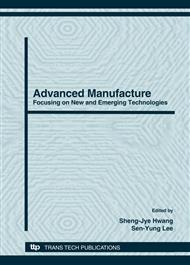p.1
p.7
p.15
p.22
p.29
p.34
p.39
Mechanism Design of ITO-Layer Removal from Color Filter of TFT-LCD
Abstract:
A mechanism design for the recycling process for removing the ITO-layer from color filter surface of TFT-LCD is presented. The defect rate of the ITO-layer is easily existent through the processes of semiconductor production. By establishing a recycling process for the ultra-precise removal of the thin film microstructure, the semiconductor optoelectronic industry can effectively recycle defective products, reducing both production costs and pollution. In the current experiment, the major interest is the design mechanism features of the removal process for a thin layer of ITO. For the recycling processes, a high flow velocity of the electrolyte provides a larger discharge mobility and a better removal effect. A thin thickness of the negative-electrode, an adequate gapwidth between the negative-electrode and the workpiece, or a higher working temperature corresponds to a higher removal rate for the ITO-layer. An adequate feed rate of the color filter combined with enough electric power produces a fast removal rate. An effective mechanism design and a low-cost recycling process using the electrochemical removal requires quite a short time to make the ITO layer remove easily and cleanly.
Info:
Periodical:
Pages:
1-6
Citation:
Online since:
August 2008
Authors:
Keywords:
Price:
Сopyright:
© 2008 Trans Tech Publications Ltd. All Rights Reserved
Share:
Citation:


